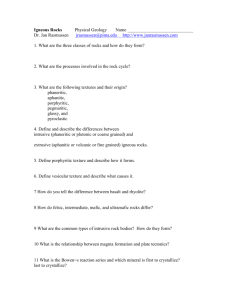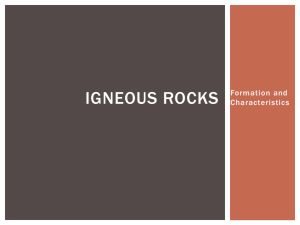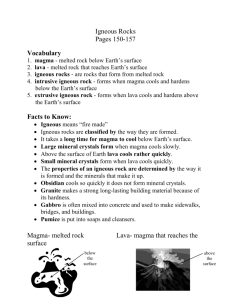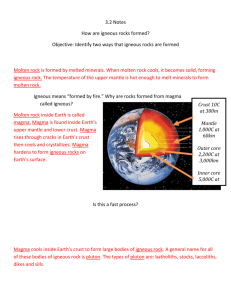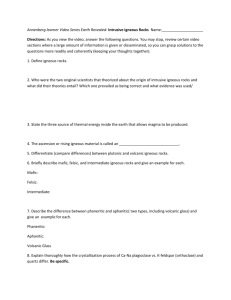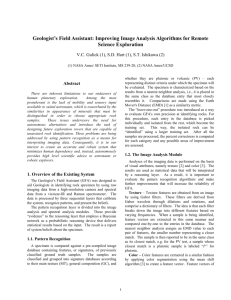Answers Quizz 6
advertisement
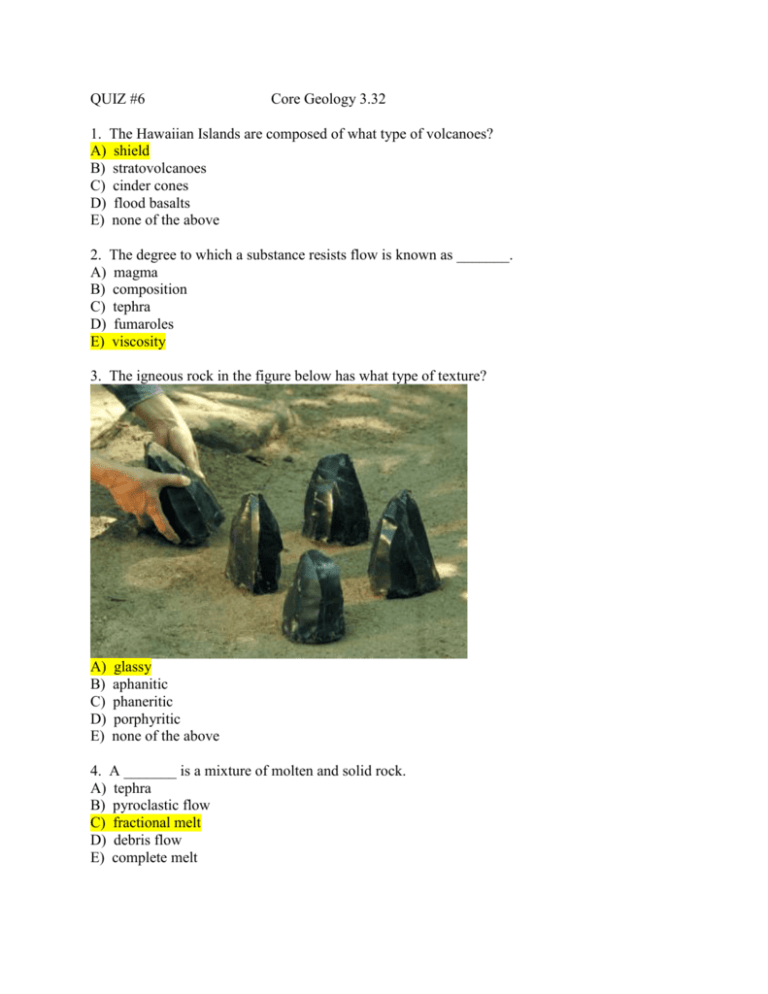
QUIZ #6 Core Geology 3.32 1. The Hawaiian Islands are composed of what type of volcanoes? A) shield B) stratovolcanoes C) cinder cones D) flood basalts E) none of the above 2. The degree to which a substance resists flow is known as _______. A) magma B) composition C) tephra D) fumaroles E) viscosity 3. The igneous rock in the figure below has what type of texture? A) B) C) D) E) glassy aphanitic phaneritic porphyritic none of the above 4. A _______ is a mixture of molten and solid rock. A) tephra B) pyroclastic flow C) fractional melt D) debris flow E) complete melt 5. The figure below is an igneous rock with what type of texture? A) B) C) D) E) glassy aphanitic phaneritic porphyritic none of the above 6. The figure below has what type of texture? A) B) C) D) E) glassy aphanitic phaneritic porphyritic none of the above 7. Which of the following terms best describes the lava in the figure below? A) B) C) D) E) low viscosity high viscosity crystallized fractionated none of the above 8. The smallest type of tephra is known as _______. A) lapili B) volcanic ash C) agglomerates D) pyroclasts E) calderas 9. Fine grained igneous rocks have a _______ texture. A) aphanitic B) phaneritic C) porpyritic D) glassy E) vesicular True/False 10. The presence of higher amounts of water usually results in the lower of the melting temperature. TRUE 11. Hawaiian eruptions are extremely violent and produce large pyroclastic flows. FALSE 12. Igneous rocks high in feldspars and silicates are known as felsic rocks. TRUE 13. Vulcanian eruptions are not very explosive and only release ash 5km into the air. FALSE Fill-In-The-Blank 14. The most violent volcanic eruptions in history are classified as _______ eruptions. Plinian 15. When magma is injected horizontally between layers and solidifies, a _______ forms. Sill 16. Igneous rocks with small crystals undergo _______ cooling. Fast Short Essay 17. Other than lava flows, please list three hazards associated with volcanoes. Primary hazard- shaking, explosion; secondary – mudslides (lahars), tremors, tsunamis, floods; climate change – increase of acid rains. 18. Contrast the igneous rock textures associated with those rocks formed internally and externally. Cooling rate determines the crystal size. If the cooling rate is slow – rock has bigger crystal size, faster – rock has smaller grains size. We can classify igneous rocks into 2 types – volcanic (same as extrusive) which has small grains or crystal size and plutonic (same as intrusive) which has bigger grains or crystals. Igneous rocks textures - phaneritic (visible grains), porphyritic (mixture of small crystals in a ground mass), and alphanitic (fine grained texture). 19. How does the presence of water affect the melting temperature of a rock? More water in the rock – less temperature we need to melt it, it’s easier to melt the rock. 20. Discuss the difference between a sill and a dike. A dike is an intrusive body of magma that intrudes vertically and a sill is an intrusive body of magma that intrudes horizontally. 21. What is the correlation between volcanoes and plate boundaries? Volcanic activity occurs along plate boundaries. The great majority of the world's active volcanoes are located along plate boundaries. Volcanoes are generally found in convergent type of boundaries (subduction zones). This generates a lot of geologic activities such as earthquakes, mountain buildings, and volcanoes formation. Water released from the subducting plate lowers the melting temperature of the overlying mantle wedge and creates magma. Usually this magma is more viscous because it contains high amount of silica. This magma often does not reach the surface and cools at depth. When it does reach the surface, a volcano is formed.
